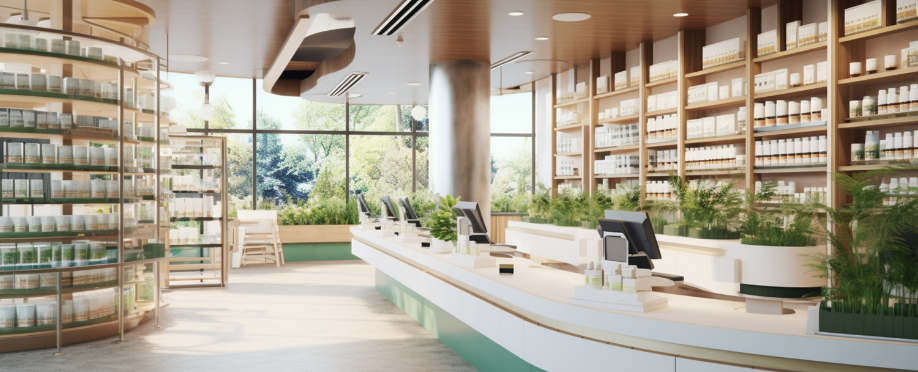
In the retail industry, where every aspect of store design is meticulously crafted to drive sales and enhance the customer experience, energy efficiency can often take a back seat. But in the current landscape of rising energy costs, stricter regulations, and more eco-conscious consumers, an increasing number of retailers are recognizing the importance of sustainability for new stores and remodels.
“From optimizing the efficiency of building systems to managing the GWP potential of refrigerants, more and more retailers are focused on sustainable store design to meet environmental goals and reduce operating costs,” says John Pulley, VP of MEP Services for CBES (City Building Engineering Services).
Keep reading for some of John’s top retail store design strategies, which prioritize energy efficiency for greener stores and significant cost savings.
What Is Retail Store Design?
Retail store design often refers to the process of optimizing the layout and physical elements of a retail space, including layout, lighting, signage, product displays, and fixtures, in order to facilitate a positive customer experience and drive sales.
But that’s just one aspect — retail store design also incorporates engineering best practices for sustainability and energy efficiency by optimizing systems such as HVAC (Heating, Ventilation, and Air Conditioning), lighting, and MEP (Mechanical, Electrical, and Plumbing) in a way that minimizes energy consumption while maintaining a comfortable environment for customers and associates.
| For store design best practices specifically geared toward food retailers, check out our article, Sustainable Grocery Design: 4 Common Mistakes. |
Retail Store Design Best Practices for Energy Efficiency
1. Stay flexible
When designing a retail store, John emphasizes the importance of flexibility. “It’s important that the design doesn’t box you in,” he says. This means creating a layout that doesn’t restrict future store modifications or remodels.
In particular, John recommends including designated areas for electrical gear and remote panels in order to allow for easier access and maintenance and to avoid costly updates in the future caused by haphazardly placed electrician components. “By strategically planning the layout, retailers can save themselves a lot of trouble with future store upgrades,” he says.
By strategically planning the layout, retailers can save themselves a lot of trouble with future store upgrades.John Pulley, VP of MEP Services for CBES
2. Utilize energy-efficient equipment
When renovating stores, one of the lowest-hanging-fruit solutions for reducing energy consumption is upgrading old or inefficient equipment. “It’s not uncommon to find equipment that has exceeded its serviceable life,” John explains.
While retailers may be tempted to reduce remodel costs by putting off upgrades, it’s important to note that it can cost more to run equipment than to just replace it, John notes. So instead of saving money, retailers end up increasing their overall operating costs.
Even newer equipment, while still functional, may be inefficient. Replacing these with high-efficiency assets can make a substantial difference in a store’s power bill — not to mention its carbon footprint. This is particularly the case with HVAC equipment such as chillers, boilers, rooftop units, and variable refrigerant flow (VRF) systems. When selecting new equipment, efficient system sizing is key. For example, HVAC systems should meet the specific heating, cooling, and ventilation needs without oversizing, thereby reducing energy waste.
3. Optimize lighting
Except for refrigeration in supermarkets and grocery stores, out of all building systems, lighting is the most critical when it comes to retail environments, as it plays a vital role in highlighting merchandise and creating an inviting ambiance for customers.
Opting for LED lighting in a retail store design not only enhances visibility and color accuracy, but it also reduces maintenance costs thanks to the longer lifespan of LED bulbs, which according to the Environmental Protection Agency, last 15 times longer than traditional incandescent bulbs. They also provide the same level of brightness but consume 90% less energy.
As part of the store design process, retailers should ensure lighting systems are designed with energy-efficient fixtures and controls as well as daylighting strategies, which use natural sunlight during daytime hours to reduce energy use.
4. Prioritize commissioning
Commissioning is the process of testing and optimizing all MEP equipment and assets to ensure they operate as intended by the manufacturer and at optimal efficiency. This ultimately leads to lower energy consumption, lower maintenance costs, longer equipment life, and a reduced carbon footprint.
Commissioning should be paired with continuous commissioning — that is, the monitoring of building systems in real time — to make sure systems continue to operate at peak efficiency. Should continuous commissioning specialists encounter any anomalies, they can then take action with remote adjustments or, if necessary, dispatch on-site service technicians.
“Lighting is the most important system for retailers to prioritize for commissioning, as it consumes the most power,” says John. “Commissioning will ensure lighting fixtures are properly calibrated, reducing energy waste and ensuring optimal illumination levels throughout the store.”
5. Plan the fire protection system carefully
Especially for dry retail environments, which often feature an abundance of plastics and other fire hazards, it’s important to be aware of fire protection codes as part of the store design. Stack heights and product arrangements should be assessed to ensure compliance with underwriter requirements, which may specify higher densities of fire protection.
“The specific requirements depend on factors such as the types of products, stacking heights, and storage locations,” says John. While supermarkets often adhere to a standard of 0.2 gallons per minute per 1,500 square feet, the standard may need to be doubled for other retailers in accordance with their storage practices.
6. Integrate green building codes
With today’s continually evolving environmental regulations, it’s important to stay up-to-date on states’ green building codes. For example, an increasing number of codes require energy recovery equipment, which extracts energy from exhausted air to treat the temperature of outside air, reducing energy demand for heating and cooling.
In New York City and other areas, initiatives for eliminating fossil fuels for heating are promoting the use of electricity-based systems like Variable Refrigerant Flow (CRF) technology. VRF systems are used to adjust energy capability to the building’s current load, which is particularly useful for efficiently heating and cooling during the transitional “shoulder” seasons. VRF technology also allows for separate air handles to be installed in different rooms, which makes it possible to adjust temperatures from the same unit for individual spaces. The result is less energy consumption and a more comfortable environment for both customers and store associates throughout the year.
7. Implement energy optimization strategies
In addition to upgrading and optimizing equipment, retailers can employ other strategies for minimizing energy usage in their retail store design. For instance, zoning strategies involve dividing the store into distinct areas with varying heating and cooling needs. This allows facilities teams to manage energy based on occupancy patterns and activity levels.
Advanced control systems can also give facilities precise control over HVAC equipment, lighting, and other building systems, ensuring optimal performance. Additionally, DCV (demand-controlled ventilation) systems automatically adjust ventilation according to occupancy levels and indoor air quality requirements. With such systems in place, retail stores can further reduce energy waste while maintaining a healthy indoor environment.
8. Utilize Energy Management Systems
The majority of companies that have implemented EMS (energy management systems) have realized two to three times the annual energy savings as those without an EMS, according to the United Nations Industrial Development Organization.
Implementing EMS to monitor and control various building systems, including HVAC and lighting, allows facilities to continuously monitor energy use in one central location. When temperatures or consumption spike unexpectedly, FM teams can either take action remotely or dispatch a technician — before issues lead to soaring energy bills or costly breakdowns.
Retail Store Design for the Future of Retail
As the retail industry and the regulatory landscape continue to evolve, so do the priorities and practices of store design. While traditionally the focus has been on enhancing the customer experience and maximizing revenue, the importance of energy efficiency is quickly gaining momentum.
CBES is dedicated to helping our customers reduce their emissions and energy costs. Reach out to our team to learn more about our end-to-end engineering, programming, and sustainability solutions.


 2016: City US is established in North America, in partnership with Southeastern Grocers (SEG), servicing over 750 supermarkets across 7 southern states.
2016: City US is established in North America, in partnership with Southeastern Grocers (SEG), servicing over 750 supermarkets across 7 southern states. 1985: Willie and Susan Haughey establish City Refrigeration Holdings (UK) Ltd in Glasgow, UK.
1985: Willie and Susan Haughey establish City Refrigeration Holdings (UK) Ltd in Glasgow, UK. 2009: City Australia launches in Melbourne, in partnership with Coles, servicing over 700 supermarkets across the country.
2009: City Australia launches in Melbourne, in partnership with Coles, servicing over 700 supermarkets across the country. 2015: City Asia launches in Kuala Lumpur, Malaysia, in partnership with Dairy Farm, servicing over 205 supermarkets across the region.
2015: City Asia launches in Kuala Lumpur, Malaysia, in partnership with Dairy Farm, servicing over 205 supermarkets across the region.